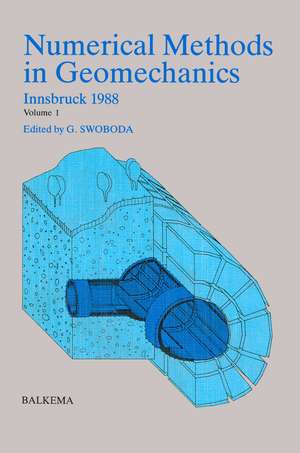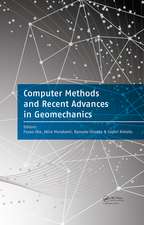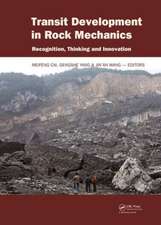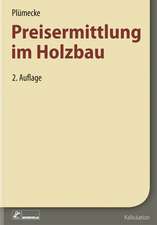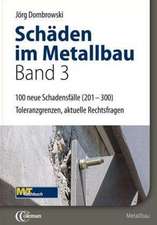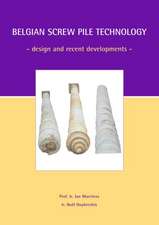Numerical Methods in Geomechanics Volume 1
Autor G. Swobodaen Limba Engleză Hardback – 1988
Preț: 1958.37 lei
Preț vechi: 2388.26 lei
-18% Nou
Puncte Express: 2938
Preț estimativ în valută:
374.72€ • 391.28$ • 309.44£
374.72€ • 391.28$ • 309.44£
Carte tipărită la comandă
Livrare economică 15-29 aprilie
Preluare comenzi: 021 569.72.76
Specificații
ISBN-13: 9789061918103
ISBN-10: 9061918103
Pagini: 716
Dimensiuni: 178 x 254 x 38 mm
Greutate: 1.38 kg
Ediția:Revised edition
Editura: CRC Press
Colecția Routledge
ISBN-10: 9061918103
Pagini: 716
Dimensiuni: 178 x 254 x 38 mm
Greutate: 1.38 kg
Ediția:Revised edition
Editura: CRC Press
Colecția Routledge
Cuprins
Main lectures; 1: Behavior and simulation of soil tunnel with thin cover; 2: Progress in BEM applications in geomechanics via examples; 3: Application of analytic and semi-analytic techniques to geotechnical analysis; 4: Incrementally multi-linear and non-linear constitutive relations: A comparative study for practical use; 5: Unified approach for constitutive modelling for geologic materials and discontinuities; 6: Dynamic nonlinear hysteretic effective stress analysis in geotechnical engineering; 7: Some numerical techniques for free-surface seepage analysis; 8: Numerical methods versus statistical safety in geomechanics; 9: Simulation of hydraulic fracture in poroelastic rock; 10: A modelling of jointed rock mass; 11: Some recent developments in interactive computer graphics for 3-D nonlinear geotechnical FEM analysis; 12: Static and dynamic approaches to rock burst phenomena; 13: Two ‘Class A’ predictions of offshore foundation performance; 14: Numerical modelling of tunnel blasting; 15: Stability and bifurcation in geomechanics; 16: Simple models for soil behaviour and applications to problems of soil liquefaction; 1: Numerical techniques and programming; 17: Experiences with the analysis of geotechnical problems solved by the FEM using different equation solvers on several computers; 18: Some computational experiences of a geomechanical benchmark in rock salt; 19: Improved algorithm for non-linear analysis by the finite element method; 20: A unified approach to the analysis of saturated-unsaturated elastoplastic porous media; 21: Uni-axial wave propagation through fluid-saturated elastic soil layer; 22: Formulations and a methodology for computing the response of unsaturated soils to changes in temperature; 23: Several aspects of formation of structures of computer programs, selection and algorithmization of medium models in geomechanics; 24: A boundary integral code based on a variational formulation; 25: The use of Lees’ algorithm in the analysis of some ground heat and mass transfer problems; 26: Hybrid finite element model utilized for fracture of concrete beams on elastic foundations; 27: Limit analysis of plane problems in soil mechanics; 28: Displacement discontinuities and interactive graphics for three-dimensional, hydraulic fracturing simulators; 29: Stress analysis of large structures in hydraulic engineering by weighted residuals method; 30: An automatic soil parameters identification software; 2: Constitutive laws of geotechnical materials; 31: Generalized constitutive equations of saturated sand; 32: A cyclic viscoplastic constitutive model for clay; 33: Coupled elasto-plastic deformation-flow finite element analysis using imaginary viscosity procedure; 34: Strength behavior of granular materials using discrete numerical modelling; 35: A complete constitutive law for soil structure interfaces; 36: Numerical investigations on discharging silos; 37: A generalization of Hvorslev’s equivalent stress; 38: Incremental theory of elasticity and plasticity under cyclic loading; 39: Numerical simulation of the behaviour of saturated sand; 40: A constitutive model of soils for evaluating principal stress rotation; 41: Assessment of a new class of implicit integration schemes for a cone-cap plasticity model; 42: Model and parameters for the elastic behaviour of soils; 43: Discontinuous numerical model for partially saturated soils at low saturation; 44: Modelling the development of rupture surfaces using displacement-type finite element methods; 45: Constitutive subroutine to simulate alternating loading of granular materials; 46: Constitutive equation of tertiary sedimentary mudstone considering strain hardening and strain softening; 47: Theoretical evaluation of the frictional damping of rocks; 48: Analysis of the cone penetration test by the strain path method; 49: Constitutive laws including kinematic hardening for clay with pore water pressure and for sand; 50: An anisotropic hardening model for the mechanical behaviour of clay; 51: Three-dimensional shearing deformation of sand; 52: Model of sand behaviour towards shearing and compressibility in three-dimensional conditions of stress and strain; 53: Elasto-plastic anisotropic hardening model for sand in a wide stress region; 54: Cap parameters for clayey soils; 55: A constitutive model with two yield surfaces for soils; 56: Verification of elasto-viscoplastic model of normally consolidated clays in undrained creep; 57: A solution method for continua with continuously varying stiffnesses; 58: Mathematically consistent formulation of elastoplastic constitutive equations; 59: On errors involved in the experimental-numerical investigation in triaxial compression tests; 60: Non-associated flow rules in computational plasticity; 61: Constitutive relations with general Masing rule under multi-dimensional stress condition; 62: Some constitutive laws for creeping soil and for rate-dependent sliding at interfaces; 63: Model with multiple mechanisms for anisotropic behaviours of sands; 64: On the constitutive equations of the chalk; 65: Mathematical modelling and prognose dimensions of karst sinkholes in multilayered soil bases of buildings and structures; 66: A model for predicting the viscoplastic stress-strain behaviour of clay in three-dimensional stresses; 67: Effect of soil strength on numerical simulation; 68: Constitutive models constrained by the entropy maximum principle; 69: Geomechanical applications of fully coupled, transient thermoelasticity; 3: 3 Flow and consolidation; 70: Numerical analysis of soil stability around deep wellbores; 71: Numerical investigation of hydraulic fracturing in clays; 72: Consolidation analysis of soils by elasto-plastic constitutive models; 73: Deformation of a sedimentary overburden on a slowly creeping substratum; 74: Evaluation of a quasi-dynamic algorithm for soil consolidation problems; 75: Consolidation of layered soils under time-dependent loading; 76: Constitutive modelling for anisotropically overconsolidated clay; 77: Pore pressure built up as a result of wave action; 78: Modelling thermal, three-dimensional, three-phase flow in a deforming soil; 79: Finite difference analysis of consolidation by vertical drains with well resistance; 80: Interpretation of concrete top base foundation behaviour on soft ground by coupled stress flow finite element analysis; 81: On the determination of the matrix of permeability for partially saturated finite elements; 82: Imperfect underground barriers under transient seepage conditions; 83: Prediction of consolidation of elastoplastic subsoils; 84: Effects of test procedure on constant rate of strain pressuremeter tests in clay; 85: Analytical procedure for evaluating pore-water pressure and deformation of saturated clay ground subjected to traffic loads; 86: Partial-drained behaviour of clay under cyclic loading; 87: Consolidation settlements of interacting structural foundations; 88: Undrained Bearing Capacity of Anisotropically Consolidated Clay; 89: Three-dimensional bearing capacity analysis of clays under partially drained condition; 90: The effect of anisotropy on consolidation in a soil layer; 91: Flow analysis of clay layer due to berth construction
Descriere
This book is based on the papers presented at the 6th International Conference on Numerical Methods in Geomechanics in Innsbruck from 11–15 April 1988. It presents a derivation of an analytical method in due consideration of mechanical interaction between groundwater and surrounding ground.
